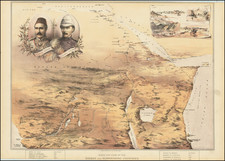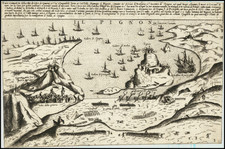From A Distinguished 19th Century French Collection
Fine map of the Constantine Province, in modern day Algeria.
The map is annotated to shown the routes of the French Military in the 1840s.
On October 13, 1837, the territory was captured by France, and from 1848 on until 1962 it was an integral part of the French motherland and center of the Constantine Département.
The map includes the stamp of Capitaine Bocher, which would be René Paul Emmanuel Bocher.
France and Algeria in the nineteenth century
The bustling port city of Algiers, and what would become the country of Algeria, was an autonomous region of the Ottoman Empire at the beginning of the nineteenth century. Its provincial ruler (dey) controlled Algiers and its surroundings; numerous inland tribal leaders pledged loyalty to the Sultan in Constantinople. Along the Barbary Coast, piracy and the slave trade were the main economic activities and the source of Algiers’ wealth, along with the region’s considerable wheat crops. European powers and the United States sought to end Algerian privateering and Christian slavery and took naval action against Algiers and the Barbary corsairs in 1815.
Relations between France and Algiers had flourished during the Napoleonic Wars with Algiers benefitting from France’s large food import demands. Trouble began when France bought fourteen million pounds of wheat on credit from two traders in Algiers, Bacri and Busnach, but refused to pay back the debt. Bacri and Busnach were themselves in debt to the Ottoman ruler in Algiers and unable to pay until France paid them, leading to mounting tensions between Algiers and France.
The 1827 “Fly Whisk Incident”
On April 29, 1827 the Ottoman ruler in Algiers, Dey Hussein ben Hassan, slapped the French consul Pierre Deval with his fly whisk (a switch-like tool commonly used to swat flies). Dey Hassan was angry over the longstanding French debt and Deval had recently strained relations further by supervising illegal fortification of French trading posts on the Dey’s territory. Accounts claim that the two men exchanged insults, leading to the Dey striking Deval.
For the French, this diplomatic faux pas represented an opportunity: the French were concerned about British political and commercial influence in North Africa, veterans of the Napoleonic wars needed employment, and the current monarchy could use an overseas entanglement to direct public attention away from issues at home. The Fly Whisk Incident set off a years-long French naval barricade and embargo of the port of Algiers. After failed negotiations in July of 1829, the King’s emissary, Captain de la Bretonnière, was fired upon by Ottoman Algerian forces; the French then began their conquest of Algeria in 1830.
French conquest of Algeria (1830-1847)
On June 4, 1830, the French army, led by General de Bourmont, landed about fifteen miles west of Algiers in Sidi-Ferruch and was met by opposition from Ottoman Janissary and native Kabyle forces. Fighting lasted for three weeks, with Algerian forces sustaining major losses. Dey Hassan was forced to surrender, and the French took control of Algiers on July 5, 1830.
Just two weeks after capturing Algiers, the Bourbon monarchy of Charles X fell to the “Citizen King” Louis Philippe, who decided to continue the inherited military campaign. However, native Algerian resistance to French colonization proved difficult for the French forces to battle. At the time of formal annexation in 1934, for example, French occupation was still confined mainly to coastal towns and isolated outposts.
Emir Abdelkader was the religious and military leader of the Algerian guerilla resistance and at one point his forces controlled more than two-thirds of Algerian territory. The French military fought a drawn-out, bloody battle against Abdelkader and other resistance forces which eventually ended with Abdelkader’s surrender in 1847.
Capitaine Bocher
René Paul Emmanuel Bocher (1835-1919) rose to the level of General in the French Military, Knight of the Legion of Honor, Senator, artist, engraver and was a well regarded art critic and author.
Bocher came from a distinguished family which included a senator and a general. But Bocher is known today principally as a writer on art, the author of catalogs of the works of Gavarni, Lavreince, Baudouin, Chardin, Lancret, St. Aubin and Moreau le Jeune as well as other studies.
Bocher's own collection focused on the original drawings for book illustrations, of which he had a massive and important assembly. He also had a collection of prints and drawings by Charlet, said to have been obtained from his father-in-law, the Count de Pajol. The illustration drawings were apparently sold privately and probably the Charlet prints as well, for the two auctions of Bocher’s estate, in 1921 and 1922, mention only paintings and some old master drawings among the furniture, bronzes and objets d’art.












![[ Ethiopia, Sudan & Eritrea ] Nubia and Abysssinia](https://storage.googleapis.com/raremaps/img/small/101736.jpg)
![(North Africa) La Barbarie et l'Egypte [on sheet with] Sein de Carthage [on sheet with] Aegypte](https://storage.googleapis.com/raremaps/img/small/85149.jpg)

![Fezzae et Marocchi Regna Africae Celeberrima, describebat Abrah: Ortelius. [Fez and Morocco, the most famous Kingdoms of Africa, as described by Abraham Ortelius]](https://storage.googleapis.com/raremaps/img/small/94255.jpg)
![(North Africa) Barbaria [Barbary]](https://storage.googleapis.com/raremaps/img/small/97498.jpg)